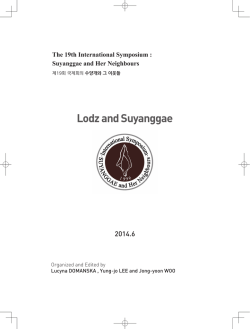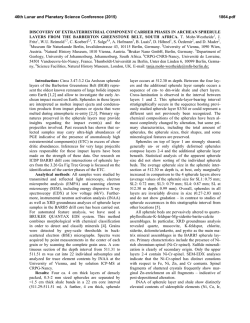
THE GEOMORPHOLOGY OF COMET 67P: IMPLICATIONS FOR
46th Lunar and Planetary Science Conference (2015) 1532.pdf THE GEOMORPHOLOGY OF COMET 67P: IMPLICATIONS FOR THE PAST COLLISIONAL EVOLUTION AND FORMATION. S. Marchi1, H. Rickman2, M. Massironi3, F. Marzari3, M. R. El-Maari4, S. Besse5, N. Thomas4, C. Barbieri3, M. A. Barucci 6, S. Fornasier6, L. Giacomini 3, H. U. Keller7, E. Kuehrt8, P. Lamy9, M. Lazzarin3, S. Mottola8, G. Naletto3, M. Pajola3, H. Sierks10; 1Southwest Research Institute ([email protected]), 2 Uppsala University, 3Padova University, 4University of Bern, 5ESA Villanueva and Noordwijk, 6Observatoire de Paris, 7Institute for Geophysics Braunschweig, 8DLR Berlin, 9LAM Marseille, 10MPS Goettingen. Introduction: Images acquired by the OSIRIS camera system on board Rosetta revealed comet 67P Churyumov-Gerasimenko complex surface. Several distinct morphological units have been identified and mapped (Fig. 1; [1]). These units are characterized by the presence of i) smooth terrains (presumably covered by particles smaller than OSIRIS resolution, even at the highest resolution of ~10 cm/pixel); ii) large pits (possibly related to outgassing); and iii) seemingly competent materials (presumably organic-rich as revealed by the VIRTIS spectrometer [2]). and ultimately provide constraints on the nucleus internal structure. The overall shape of the two lobes of 67P also provides an important constraint on the bulk structure. All together, these features bear important implications for the origin of 67P. Here we present a first analysis of some of the key features that could provide constraints on the internal structure of 67P, and discuss their implications for its origin in the framework of most recent models of cometesimal formation and their subsequent evolution. Layers and Fractures: Layers are observed in various locations on 67P. Some of them may be entirely due to surface processes, such as sublimation lag deposits. In one region (Seth; Fig. 2), however, lineaments are seen in the dust-free walls of large pits. Figure 1: Main geomorphological units mapped on 67P [1]. The large and small lobes are refereed to as the body and head, respectively. The connecting region is refereed to as the neck. Some of these features, e.g. pits and smooth terrains, were also observed on other comets visited at close range [3,4]. However, their interpretation remains for the most part speculative due to the lack of extensive coverage and insufficient spatial resolution. Both aspects are considerably improved by OSIRIS imaging. As a result, processes such as airfall deposition and sculpting of fine-grained deposits have been clearly detected [1]. These features are some of the footprints of cometary activity on 67P's surface. In addition, a number of intriguing features, such as extensive layering and fracturing, may reveal bulk properties of the nucleus, rather than due to surface processes and cometary activity. These features are important because may complement observations of other instruments (such as the CONSERT radar [5]), Figure 2: The region highlighted in blue (Seth) is characterized by the presence of many large pits. Most of them exhibit lineaments in their walls and have flat floors, some of which are indicated by green lines. These lineaments seem to be parallel to the floors of these pits, which are remarkably flat. A likely interpretation is that the lineaments on the walls are expression of internal layering, as well as the pits' floors. Intriguingly, the 3D orientations of these layers (derived using a high resolution shape model) can be followed through the body and appear to be aligned with a characteristic ridge (topographic high) seen on the other side of the body. Unless a mere coincidence, this observation may indicate that the putative layers consti- 46th Lunar and Planetary Science Conference (2015) tute a well-defined and organized structure that extend for a significant volume of the body. The head (and particularly the large cliff named Hathor; Fig. 3) also shows a characteristic set of lineaments that may have a similar nature, however their extension cannot be traced through the head due to lack of coverage (the relevant regions are currently in shadow and would become visible closer to perihelion). Figure 3: A close-in view of Hathor region. Red lines indicate fractures, green lines indicate layers, while orange lines indicate the presence of distinct sets of fractures/lineaments that may indicate the presence of two additional bodies (see text). The Hathor region is also characterized by an impressive set of fractures that run for hundreds of meters from the base of the head (the neck) to its summit (Fig. 3; see also [6] for a comprehensive analysis of 67P's fractures). These fractures are several meters wide and deep. The terrain on the Hapi region on the neck (at the head's base; Fig. 1) contains smooth and bouldery materials. The latter could be due to erosion of Hathor and, perhaps, related to the formation of the fractures. The estimated volume of the fractures, however, is far exceeding that of the exposed boulders at the base. Unless boulders erode on a time scale much faster than fractures growth, it seems unlikely that these fractures are uniquely due to erosional processes. Moreover, a 3D analysis of the orientations of the fractures suggests they may penetrate deep into the head. Support to this conclusion comes from the observation that a large, 1 km-across depression at the summit of the head. Whether this depression is the result of a collapse or an outburst, its rhombic shape indicates the presence of planes of weakness within the head, which appear to be aligned with the Hathor's fractures system. It is therefore possible that these fractures are indeed structural features. Implication for 67P's internal structure: The observations above, although still preliminary, open up 1532.pdf an interesting perspective to the internal structure of 67P. First, the two lobes seem to have rather district internal properties. The larger body exhibits internal layering, while the head is characterized by an impressive set of fractures, along with an orthogonal set of layers. Furthermore, the orientations of the sets of layers are not compatible with them being expression of a unique set of layers. The simplest explanation of these observations is that the head and the body are two distinct objects that merged. Support to this conclusion arrives also by the observation that the neck region shows evidence for the presence of additional small bodies, perhaps formed as result of the collision between the head and the body (Fig. 3). It is also possible that 67P characteristic shape is the result of localized erosion that would have carved the original body into a two lobes shape. While erosion can certainly have played a role in shaping the current 67P [7], it does not simply explain the cross-cutting presence of layering and fracturing. If the above inferences on the internal structure of 67P are correct, then we can interpret them in terms of implications for other Rosetta instruments. For instance, an internal structure characterized by layers and fractures offers multiple planes of reflection, potentially detectable by the CONSERT radio experiment. Furthermore, if the lobes are two independent objects it is possible that the head and the body could have distinct compositions, even if a similar composition does not rule out the two objects hypothesis. Preliminary conclusions: The presence of internal layers and extensive fracturing, if confirmed, has vast implications for 67P origin. First, the formation of deep fractures likely requires an energetic process, such as a collision. The same is true for the presence of additional fragments in the neck region. Collisions can take place at various stages during the lifetime of a comet. They may be part of the formation process in the trans-neptunian primordial disk, provided the surface density of cometesimal were high enough, or may be part of the subsequent collisional evolution within the scattered disk, the most likely reservoir of Jupiter family comets. Further work is required to be able to disentangle which of the two possible pathways is more compatible with the current 67P, but the game is afoot. References: [1] Thomas et al. (2015) Science, in press. [2] Capaccioni et al. (2015) Science, in press. [3] Thomas et al. (2013) Icarus 222, 453–466. [4] Britt et al. (2004) Icarus 167, 45–53. [5] Kofman et al. (2014) AGU Fall meeting, Abstract #P34B-01. [6] El-Maari et al., this meeting. [7] Lamy et al. (2014) AGU Fall meeting, Abstract #P41C-3937.
© Copyright 2026
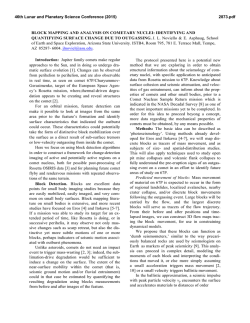
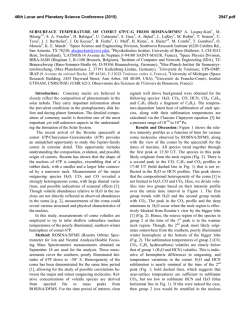

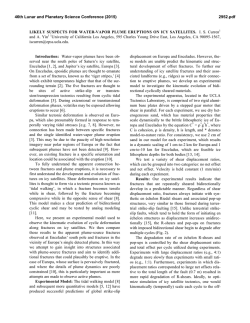

![Download [ PDF ] - journal of evolution of medical and dental sciences](http://s2.esdocs.com/store/data/000508090_1-a9a933ff37237d5430f2b15a1b23af4a-250x500.png)
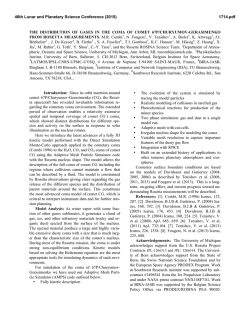
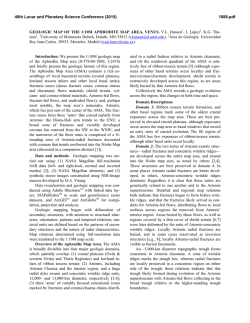
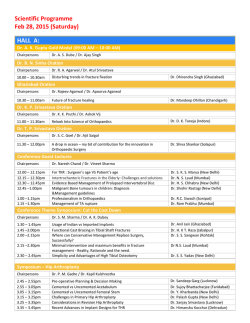
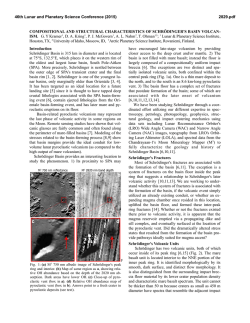

![Download [ PDF ] - journal of evidence based medicine and](http://s2.esdocs.com/store/data/000499424_1-04d992fdfa565a1fea9304f6c0faeaf7-250x500.png)

